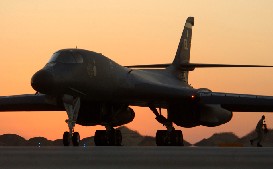Laser Peening Proves to be the Solution for the B-1B Lancer's Engine Failures
Application of laser peening avoided over $59 million in blade replacement costs, secondary damage engine repair costs, and cost avoidance from airfoil failures.
Posted: July 27, 2008
By: wpengine

General Electric Aircraft Engines (GEAE) investigated an innovative technology, called Laser Shock Peening (or laser peening), as a potential solution to increase the durability of titanium fan blades and decrease the sensitivity to FOD. Laser peening uses a high energy laser pulse to create an intense shock wave into the surface of metal parts. The shock wave imparts deep compressive residual stresses, which greatly improve the blade’s fatigue properties and toughness.
The high cycle fatigue performance of laser peened blades is remarkable. Damage to an F101 blade can reduce the fatigue strength from about 75 ksi to less than 20 ksi, which is less than half of the design requirement. However, when laser peened blades are comparably damaged, they retain a fatigue strength of 75-100 ksi. Thus, laser peening restores the structural integrity of damaged fan blades! Sensitivity to FOD defects up to 1/4 of an inch in F101 blades was virtually eliminated.

Application of laser peening avoided over $59 million in blade replacement costs, secondary damage engine repair costs, and cost avoidance from airfoil failures. Avoiding catastrophic engine failures over the remaining life of the B-1B/F101 program is estimated to have saved another $40 million.
Due to this success, laser peening was applied to solve similar problems for the F110 engine blades for the F-16 Falcon, and the USAF estimates similar cost savings to the B-1B/F101 program.
LSP Technologies, Inc. has continued to improve LaserPeen® processing equipment and processing methods. With the newest generation of LaserPeen® processing equipment and the RapidCoater™ system for automating the coating overlays used in the process, LSPT has reduced the cost of LaserPeen® processing dramatically making the process affordable for many new applications!
Overall, the potential savings from laser peening are expected to easily approach $1 billion when calculating this impact over all engines in the Air Force fleet!
Interested in Seeing More?
Tell us about your application, material, or failure mechanism and we will have one of our experts reach out to you. Our extensive library of research and years of experience gives us a unique advantage to apply a finite element analysis to help diagnose the best application for your situation.
